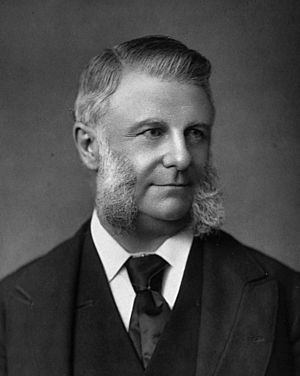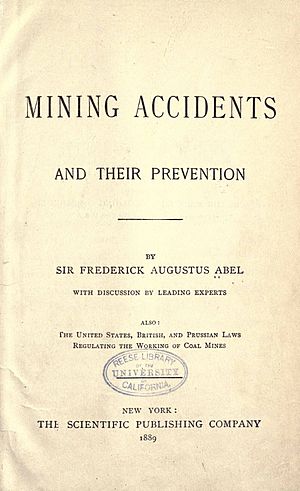Frederick Abel facts for kids
Quick facts for kids
Sir
Frederick Abel
|
|
|---|---|
 |
|
| Born | 17 July 1827 London, England
|
| Died | 6 September 1902 (aged 75) Whitehall Court, London, England
|
| Nationality | English |
| Alma mater |
|
| Known for | Cordite |
| Awards | Royal Medal (1877) Albert Medal (1891) |
| Scientific career | |
| Fields | Chemistry |
| Doctoral advisor | A. W. von Hofmann |
Sir Frederick Augustus Abel (born July 17, 1827 – died September 6, 1902) was a famous English chemist. He was known as the top expert on explosives in Britain. He is most famous for inventing a new explosive called cordite. This new material replaced older gunpowder in firearms.
Contents
Becoming a Chemist
Frederick Abel was born in London. His father was Johann Leopold Abel. Frederick studied chemistry at the Royal Polytechnic Institution. In 1845, he became one of the first students of A. W. von Hofmann. This was at the Royal College of Chemistry.
In 1852, he became a chemistry teacher. He taught at the Royal Military Academy, Woolwich. He took over this job from the famous scientist Michael Faraday.
Working with Explosives
From 1854 to 1888, Abel worked as a chemist for the British government. He was the main expert on explosives at the Royal Arsenal in Woolwich. He also advised the War Department. During this time, he did a lot of important work. His research focused on making explosives safer and more useful.
Improving Guncotton
One of his most important projects was about guncotton. This was an early type of explosive. Abel found a way to make it safer to produce. He also made it more useful by turning it into a fine pulp. This work helped create "smokeless powders." These new powders became common in the late 1800s.
Inventing Cordite
Abel worked with Sir James Dewar to invent cordite. The British government started using cordite in 1891. It was a new type of smokeless powder. Another inventor, Alfred Nobel, sued them. He said cordite was too similar to his own explosive, ballistite. However, Abel and Dewar won the case in 1895.
Abel also studied how black powder exploded. He worked on this with the Scottish physicist Sir Andrew Noble.
The Abel Test
The British government asked Abel to create a test. This test would measure the flash point of petroleum products. The flash point is the lowest temperature at which a liquid can form a flammable vapor. His first test, the open-test apparatus, was used in 1868. Later, in 1879, he made a much better test. This was called the Abel close-test instrument.
He also studied how electricity could be used with explosives. This included looking at electrical fuses.
Awards and Leadership
Frederick Abel became a member of the Fellow of the Royal Society in 1860. This is a very important science group. He received their Royal Medal in 1887. He also led several important science groups. These included the Chemical Society and the Institution of Electrical Engineers.
He was given many honors for his work. He became a Commander of the Order of the Bath in 1877. He was made a knight in 1883, so he became "Sir Frederick Abel." He was later made a baronet in 1893. This meant his title could be passed down, but he had no children.
Abel helped organize the Inventions Exhibition in London in 1885. In 1887, he became the first director of the Imperial Institute. He held this job until he died.
Later Life
Sir Frederick Abel passed away in London on September 6, 1902. He was 75 years old. He was buried in Nunhead Cemetery. He had married twice but did not have any children. Because he had no children, his baronet title ended when he died.
Books by Frederick Abel
- Handbook of Chemistry (with C. L. Bloxam)
- The Modern History of Gunpowder (1866)
- Gun-cotton (1866)
- On Explosive Agents (1872)
- Researches in Explosives (1875)
- Electricity applied to Explosive Purposes (1898)
He also wrote many articles for the Encyclopædia Britannica.
See also
 In Spanish: Frederick Augustus Abel para niños
In Spanish: Frederick Augustus Abel para niños
- Internal ballistics
Images for kids



